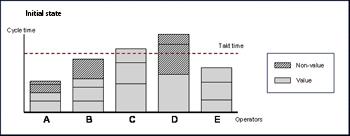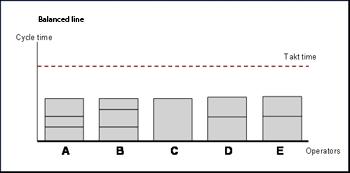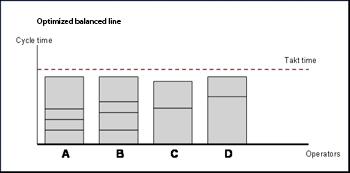TAKT Time
In Lean, TAKT Time is the rate at which a finished product needs to be completed in order to meet customer demand. If a company has a takt time of five minutes, that means every five minutes a complete product, assembly or machine is produced off the line because on average a customer is buying a finished product every five minutes. The sell rate – every two hours, two days or two weeks – is the takt time.[1]
The Importance of TAKT Time[2]
Defining TAKT time is crucial for optimizing a team’s capacity. It is important for reducing the waste of your process. Takt time can help you maintain a continuous flow of work and reduce Mura (unevenness) in your workflow. Nonetheless, takt time is valuable for optimizing storage costs as it will help you avoid overproduction. Takt time is one of the most important Lean metrics. By defining takt time for your workflow you can:
- Establish a continuous flow of work.
- Optimize your capacity to meet customer demand.
- Reduce storage costs by avoiding overproduction.
Calculating TAKT Time[3]
A common misconception is that takt time relates to the overall build time - i.e. the number of "man hours" put in to building a product. It doesn't – it relates to the time span required to build a product from start to finish to ensure the continual flow of finished products needed to satisfy customer demand. Once takt time has been established, the electronics manufacturer needs to physically separate out the build into individual stages and resource the production line accordingly.
The basic calculation is: Available production time / customer demand = takt time
Let's break this calculation down a little further:
- Available production time - for the purposes of this post, we assume the electronics manufacture operates an 8-hour shift, 5 days a week. 8 hours x 60 minutes equates to 480 total minutes - but, of course, not all the 480 minutes are "available". Tea and lunch breaks, material preparation in the morning and a clean down at the end of each shift all take away from the "available" time. So assuming there are 2 x 10-minute tea breaks, 30 minutes for lunch and another 20 minutes in total consumed at the start and end of each day, the "available" production time is in fact 410 minutes.
- Customer demand - this relates to the number of units the customer requires each day. To keep the maths simple, we will assume this customer designs and sells a range of electro-mechanical industrial printers and requires their assembly partner to produce 100 of these a day.
- Takt time - if we take our available production time (410 minutes) and divide that by our customer demand (100), the takt time equates to 4.1 minutes or 246 seconds. This means a completed unit must be finished every 246 seconds or there is a danger the electronics manufacturer will not meet their customer's demand.
Systematic Approah to Developing TAKT Time[4]
Since defining takt is demand based, you need to know how fast your work should flow to meet our deadlines. This imposes the biggest challenge for project managers and planning engineers especially if they are aiming to create an ‘’ideal’’ workflow pace for every trade in the project that is waste-free.
Since, if some trades may progress faster than takt, this would lead to excess buffers or unnecessary inventories and thus, waste. Nevertheless, if some trade’s workflow moves slower than takt, those trades will take a longer time to finish which will consequently delay their successor activities. Hence, it is essential to use a systematic approach that helsp to develop TAKT and avoid such situations as much as possible.
- Step 1: Gathering data: Prior to execution you need to know what and where exactly the work is to be done, how many trades are involved, and in what sequence these trades can proceed. This is a vital exercise since you will need the input of the people on the job (the last planners). The goal is to avoid pushing a schedule that trades should fulfil and rather to pull a preferred plan from those trades. A good start can be asking each trade what they need to finish their task, and you should encourage any comment or suggestion. At the end, you need to develop a workable flow that fits every trade’s expectations, leading to reduced task variability and ultimately a continuous workflow
- Step 2: Define your zones: Information from step one can be used to divide your project into zones. Zones are the physical areas where trades operate, and ideally the zones should be defined in such a way that all trades working in a specific zone take the same amount of time to complete their tasks in that zone.
- Step 3: Sequence the trades: Now that you defined your zones, you are better able to pull the sequence of trades by arranging coordination meetings. You need the collective input of those trades to collaboratively plan which trade goes first due to necessity or optimality. At that stage, you can establish an agreed methodology of how work can flow between the various trades.
- Step 4: Balance the workflow: You established your zones, and sequenced the trades, however it is never the case that you have a balanced workflow without some iteration. You should be on the lookout for bottleneck trade activities that need to go faster or slower to match your required takt or even you might want to readjust your zones. Prefabrication? Adding resources? More equipment? It is time to be creative!
- Step 5: Takt time planning and control: The balanced workflow rate at which activities progress in your defined zones is your defined takt time. Nonetheless, activity first trails are essential to determine the soundness of your planned takt time. Hence, you should continuously track progress to proactively note deviations from the desired takt time and take proper control actions.
Implementing TAKT Time[5]
Takt has an easy formula, but it’s one of the most difficult to implement in the Lean world.
You can start implementing takt time by first measuring individual cycle times. Insert this data into the formula in order to calculate takt time. To begin aligning your process to the takt time, start dividing the work that goes into the process into value adding and non-value adding activity.
Eliminate the non-value adding time and balance the workload of the operators.
Bring the individual cycle times closer to the takt time. Keep the line balanced. In this case you will need fewer operators.
TAKT Time - Benefits and Downsides[6]
Benefits
Once a Takt System is implemented there are a number of benefits:
- The product moves along a line, so bottlenecks (stations that need more time than planned) are easily identified when the product does not move on in time.
- Correspondingly, stations that don't operate reliably (suffer frequent breakdown, etc.) are easily identified.
- The takt leaves only a certain amount of time to perform the actual value added work. Therefore, there is a strong motivation to get rid of all non value-adding tasks (like machine set-up, gathering of tools, transporting products, etc.)
- Workers and machines perform sets of similar tasks, so they don't have to adapt to new processes every day, increasing their productivity.
- There is no place in the takt system for removal of a product from the assembly line at any point before completion, so opportunities for shrink and damage in transit are minimized.
Downsides
Downsides of Takt time organization include:
- When customer demand rises so much that takt time has to come down, quite a few tasks have to be either reorganized to take even less time to fit into the shorter takt time, or they have to be split up between two stations (which means another station has to be squeezed into the line and workers have to adapt to the new setup)
- When one station in the line breaks down for whatever reason the whole line comes to a grinding halt, unless there are buffer capacities for preceding stations to get rid of their products and following stations to feed from. A built-in buffer of three to five percent downtime allows needed adjustments or recovery from failures.
- Short takt time can put considerable stress on the "moving parts" of a production system or subsystem. In automated systems/subsystems, increased mechanical stress increases the likelihood of breakdown, and in non-automated systems/subsystems, personnel face both increased physical stress (which increases the risk of repetitive motion (also "stress or "strain") injury), intensified emotional stress, and lowered motivation, sometimes to the point of increased absenteeism.
- Tasks have to be leveled to make sure tasks don't bulk in front of certain stations due to peaks in workload. This decreases the flexibility of the system as a whole.
- The concept of takt time doesn’t account for human factors such as an operator needing an unexpected bathroom break or a brief rest period between units (especially for processes involving significant physical labor). In practice, this means that the production processes must be realistically capable of operation above peak takt and demand must be leveled in order to avoid wasted line capacity
See Also
References
- ↑ Definition - What does TAKT Time Mean? ISixSigma
- ↑ Why is Takt Time Important? Kanbanize
- ↑ How is TAKT Time Calculated? JJS Manufacturing
- ↑ The 5-Step Approach to Developing TAKT Time Primaned
- ↑ How to Implement Takt Time Process Excellence Network
- ↑ The Benefits and Downsides of TAKT Time Wikipedia




